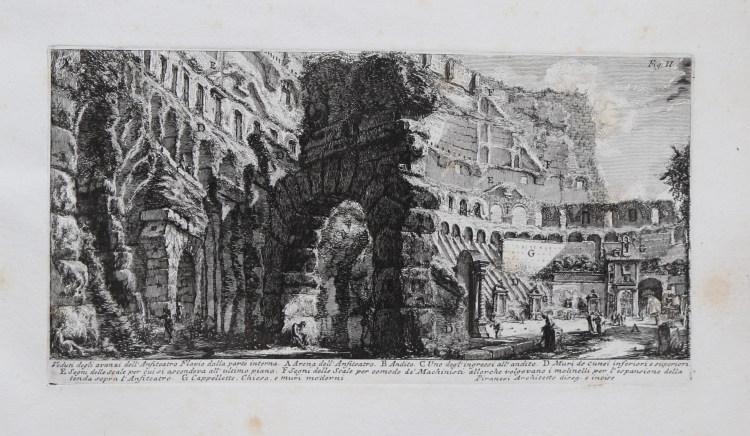



| Riferimento: | S36230 |
| Autore | Giovan Battista PIRANESI |
| Anno: | 1756 |
| Zona: | Colosseo |
| Luogo di Stampa: | Roma |
| Misure: | 270 x 140 mm |


| Riferimento: | S36230 |
| Autore | Giovan Battista PIRANESI |
| Anno: | 1756 |
| Zona: | Colosseo |
| Luogo di Stampa: | Roma |
| Misure: | 270 x 140 mm |
Acquaforte e bulino, 1756 circa, firmata in lastra in basso a destra. Dalla serie Le Antichità Romane. Meravigliosa prova, ricca di toni, impressa a inchiostro bruno su carta vergata coeva, con pieni margini ed in perfetto stato di conservazione.
Opera tratta dalla prima edizione, pubblicata a Roma nel 1756 nella stamperia di Angelo Rotili a Palazzo Massimo alle Colonne, dai signori Bouchard e Gravier, librai e mercanti in Roma con sede presso San Marcello al Corso. La raccolta conteneva un ritratto del Piranesi, inciso da Felice Polanzani, e recava una dedica a James Caulfield conte di Charlemont, dedica poi eliminata in seguito ad un litigio.
Di questa edizione originale, che venne alla luce nel maggio del 1756, sono note tre diverse tirature, connesse con le vicende del litigio con lord Charlemont, vicende documentate dal Piranesi stesso nelle sue Lettere di Giustificazione del 1757. Le diverse tirature sono riconoscibili tra loro proprio nel frontespizio del primo tomo, quello originariamente dedicato al nobile inglese, che successivamente si presenta con dedica e stemma araldico abraso, quindi con l’aggiunta di una dedica dell’autore Aevo Suo Posteri set Utilitari Publicae.
Henry Focillon, nel suo saggio del 1918, suppone che il Piranesi prepari ed incida le tavole per l’opera tra il 1750 ed il 1756, tuttavia, elementi architettonici fanno risalire alcune al 1746. In realtà le tavole più antiche utilizzate nella raccolta risalgono probabilmente ad anni ancora precedenti, come sembra suggerire sia l’estrema complessità dell’opera, legata ad un lunghissimo lavoro di preparazione e ricerca, sia l’oscillazione stilistica riscontrabile comparando le varie tavole.
Ad ogni modo, la grandiosità delle Antichità Romane del Piranesi non sta solamente nel grande lavoro grafico prodotto dall’artista: l’opera risulta infatti fondamentale come innovazione metodologica nel settore dell’archeologia a lei contemporanea, con l’utilizzo di scritti che sono essenziali per comprendere il pensiero dell’autore e l’innovazione del metodo piranesiano. Si può quindi sostenere, come giustamente fa notare il Focillon, che l’artista veneziano fondi l’archeologia moderna.
Questa innovazione comporta, però, un enorme stacco e una grande divergenza con il pensiero e la cultura ufficiale ed accademica del periodo - di derivazione anglosassone - causando enormi polemiche di cui Piranesi fu bersaglio, e il fiorire di una negativa aneddotica intorno alla sua persona, il cui scopo era quello di ristabilire l’egemonia minacciata della cultura “classica”. Il principale pensiero espresso nelle Antichità Romane consiste nel documentare e conservare in effige un patrimonio monumentale che andava di giorno in giorno sgretolandosi, linea di condotta che andava contro l’atteggiamento culturale di amatori ed antiquari, il cui piacere era puramente estetico, non disdegnando all’occorrenza, l’asporto di frammenti anche vistosi di antichità a titolo di puro collezionismo o alla stregua di souvenir. La principale novità della sua impostazione consiste nell’unificare in un solo momento le operazioni di scavo, di rilievo, le indagini strutturali e la misurazione con lo studio delle fonti letterarie, a cui egli fa riferimento diretto. Questo momento di unificazione è rappresentato dallo studio topografico, che unito alla tecnica di rilievo, alla conoscenza dei materiali e delle tecniche antiche, allo scavo ed al sopralluogo dava luce all’archeologia, ovvero lo studio della storia antica.
|
Focillon 216; Wilton Ely 351
|
Giovan Battista PIRANESI (Mogliano Veneto 1720 - Roma 1778)
|
Acquafortista, incisore, progettista, architetto e teorico italiano, considerato uno dei supremi esponenti dell’incisione topografica, sebbene il maggiore interesse egli lo mostrasse per l’architettura. Anche se solo pochi disegni architettonici sono stati realizzati, egli ebbe comunque una grande influenza, nel Neo-Classicismo europeo, attraverso contatti personali con architetti, mecenati e artisti in visita a Roma nel corso di quattro decadi. La sua prolifica produzione di lastre di acqueforti, che combinava una straordinaria immaginazione con una conoscenza delle tecniche dell’antica Roma estremamente pragmatica, diede avvio ad una nuova e duratura percezione dell’antichità. Era anche disegnatore di strutture e palchi per le feste, decoratore di interni e di mobili, così come restauratore. L’interazione di questa straordinaria combinazione di attività lo portò ad un concetto alto del disegno, sostenuto da saggi scritti. L’eredità che lasciò, relativamente alla sua visione unica della civiltà romana, fu una interpretazione immaginativa e una ri-creazione del passato che ispirarono scrittori e poeti così come artisti ed altri disegnatori.
|
|
Focillon 216; Wilton Ely 351
|
Giovan Battista PIRANESI (Mogliano Veneto 1720 - Roma 1778)
|
Acquafortista, incisore, progettista, architetto e teorico italiano, considerato uno dei supremi esponenti dell’incisione topografica, sebbene il maggiore interesse egli lo mostrasse per l’architettura. Anche se solo pochi disegni architettonici sono stati realizzati, egli ebbe comunque una grande influenza, nel Neo-Classicismo europeo, attraverso contatti personali con architetti, mecenati e artisti in visita a Roma nel corso di quattro decadi. La sua prolifica produzione di lastre di acqueforti, che combinava una straordinaria immaginazione con una conoscenza delle tecniche dell’antica Roma estremamente pragmatica, diede avvio ad una nuova e duratura percezione dell’antichità. Era anche disegnatore di strutture e palchi per le feste, decoratore di interni e di mobili, così come restauratore. L’interazione di questa straordinaria combinazione di attività lo portò ad un concetto alto del disegno, sostenuto da saggi scritti. L’eredità che lasciò, relativamente alla sua visione unica della civiltà romana, fu una interpretazione immaginativa e una ri-creazione del passato che ispirarono scrittori e poeti così come artisti ed altri disegnatori.
|